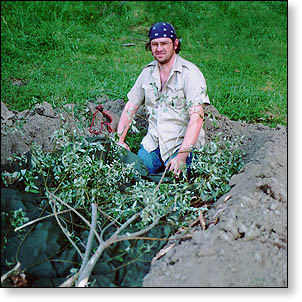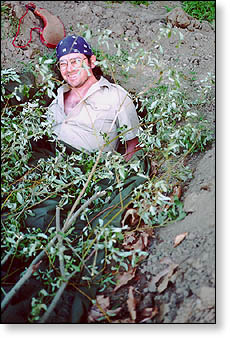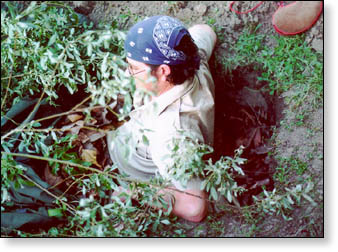

Every year at the Rattlesnake Rendezvous I try different types of bedding. This year's arrangement was a modified "Scout Pit" as I had read about them in a few different books and magazines. (For a good article on the subject, check out Wilderness Way magazine Volume 2, issue 3 pp. 43-44 article by Kevin F. Duffy.) The scout pit is basically a camouflaged and insulated trench in the ground used for sleeping. Properly constructed, it can be used in all types of weather for extended periods of time and will be almost invisible to anyone walking by. Since I was planning on using it for a only a few days in warm weather and did not want to hide it from by fellow campers, it was not as deep or camouflaged as it might have been.
I found a place that looked like it might not have too many tree roots and started digging. I used a small shovel and an abalone shell. Getting through the sod layer with the shell was almost impossible, but after that, the shell worked fine. I dug a hole about crotch-deep, about a foot longer than my height, and the width was about six inches wider than my shoulders.
Next, it was off to collect leaves. Fortunately there were lots of maple leaves nearby. I collected two ponchos full of leaves, which filled the trench. Next, I laid a grass mat on top of the leaves, and compressed the whole thing with my body weight. Then another grass mat, and another layer (two poncho loads) of leaves. Finally, I dropped my poncho on top of the filled trench, and laid a few branches on top to keep the wind from blowing things about. Construction done for today! I had intended to make a roof of sticks and earth, but I was tired at this point, and figured the poncho would suffice.


That night at bedtime, I crawled between the grass mats fully clothed and went to sleep. I soon discovered that I should have brought a pillow to bed with me. I tend to sleep on my side, and as a result my head was at an angle. I woke up the next morning with a crick in my neck, but warm and dry. The poncho was very wet with dew. The leaves had compressed overnight, so I collected more leaves before the next nightfall, and also made a pillow out of a stuffed sack. The next night's sleep was comfortable, and very warm. At one point I had to deliberately expose my upper body to cool off a bit. I had also placed a gourd canteen within arms reach in case I woke up thirsty.

The final morning, the mats were removed, and the soil put back into the trench. I found the scout pit to be a warm, dry and pleasant way to sleep. The only negative point was the amount of time and work to get it dug for only two nights. If I were going to use it for a long period of time or for repeated used, the setup time would be more justifiable. Since it was one of the few chances for me to try the scout pit, it was well worth the effort.
See ya in the woods!
E-mail your comments to "Bill Scherer" at scherer_william@hotmail.com
We hope the information on the PrimitiveWays website is both instructional and enjoyable. Understand that no warranty or guarantee is included. We expect adults to act responsibly and children to be supervised by a responsible adult. If you use the information on this site to create your own projects or if you try techniques described on PrimitiveWays, behave in accordance with applicable laws, and think about the sustainability of natural resources. Using tools or techniques described on PrimitiveWays can be dangerous with exposure to heavy, sharp or pointed objects, fire, stone tools and hazards present in outdoor settings. Without proper care and caution, or if done incorrectly, there is a risk of property damage, personal injury or even death. So, be advised: Anyone using any information provided on the PrimitiveWays website assumes responsibility for using proper care and caution to protect property, the life, health and safety of himself or herself and all others. He or she expressly assumes all risk of harm or damage to all persons or property proximately caused by the use of this information.
© PrimitiveWays 2013